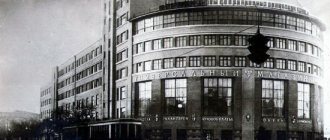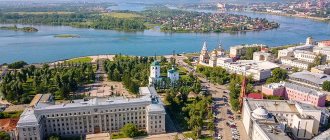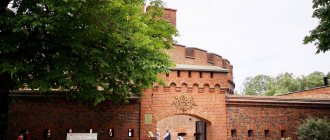Smolensk - one of the oldest Russian cities, the western outpost of Russia borders the Republic of Belarus, Tver, Bryansk, Kaluga, Moscow and Pskov regions. Since ancient times, its location determined the city’s importance in the defense of the country and the development of trade and cultural ties between peoples.
City of Smolensk (Russia)
Smolensk is an ancient city in western Russia and the center of the region of the same name. It is one of the oldest cities in the country, whose history goes back more than 1,150 years. Smolensk has played a significant role for many centuries, being a kind of key and shield of Moscow. The city, many times destroyed by wars and sieges, has preserved a magnificent historical heritage and many attractions, among which stands out an impressive fortress wall with towers and a whole scattering of ancient churches.
Square of Memory of Heroes
Throughout history, many places have appeared in the city of Smolensk where residents could express their gratitude and respect to people who gave their lives for the peace and well-being of their fellow villagers. One of these places is the square near the Donets Tower, on the territory of which the heroes are buried. Among them is the legendary Mikhail Egorov, who, together with Kantaria, planted the Soviet flag over the Reichstag.
The Eternal Flame of Glory, busts of great commanders and a monument to the heroes of the war of 1812, which is called the “Monument with Eagles,” are also located there. It represents a nest guarded by two eagles. It looks symbolic and conveys the spirit of the Russian people.
Guides: Russia
Moscow
Saint Petersburg
May be interesting: Other cities in Russia
Food
The Beryozka dining room (Kozlova, 3a) looks unprepossessing, but the food there is delicious, which confirms the lack of empty seats at lunch. The student canteen (Kommunisticheskaya, 21) is the cheapest place in the city, where lunch costs 120 ₽: solyanka - 28 ₽, pork cutlet - 52 ₽, vegetable stew - 25 ₽, dried fruit compote - 15 ₽. The menu clarifies that peklevanny bread is a term from the 18th–19th centuries, which means finely ground flour, most often rye. At the Bufet cafe (Przhevalskogo, 2), a business lunch costs a little more - 150 ₽ (soup, hot dog/burger and tea), and falafel will cost 160 ₽. At the Khlebnaya Manufactory bakery (11 locations in the city), you can buy artisan bread and have a snack of hot pastries with coffee. Bar "Mayakovsky" (Mayakovsky, 3) - blues, jazz and business lunch for 150-250 rubles with two slices of bread, which is emphasized in the menu. Have a non-trivial and leisurely meal at the “Claws and Tails” rack (Gagarina, 8). The main specialty is crayfish, 1600 ₽/kg. For coffee, go to Coffeebook (October Revolution, 6, and two other cafes) or Anderson (Przhevalsky, 6/25).
Geography and climate
Smolensk is located in the west of the European part of Russia, 400 km from Moscow, near the border with Belarus. The city is located on the Smolensk Upland, indented by picturesque ravines and valleys of small rivers. Smolensk lies on the banks of the Upper Dnieper, which divides the city into two parts. The historical core is located on the left bank of the river.
Smolensk has a temperate continental climate, characterized by warm and rainy summers and moderately cold winters. The best time to visit the city is from May to September.
View of Smolensk from the banks of the Dnieper
Popular message topics
- Inedible mushrooms
All mushrooms can be divided into edible, conditionally edible, inedible and poisonous. Inedible mushrooms are those that, for one reason or another, are not suitable for food. For example, they have an unpleasant taste or odor, require long-term processing, - June beetle (description, species, where they live)
Among the many species of insects that live on our planet, everyone knows beetles. This is a very numerous order; it differs from others in that the beetles have two pairs of wings, one of which is transparent and thin, - Thermometer (thermometer)
With the development of sciences such as physics and mathematics, various instruments for measuring people gradually began to appear. For example, a barometer measures atmospheric pressure, a hygrometer measures humidity, and a dynamometer measures force.
Story
Smolensk is one of the first cities of Rus'. Its exact founding date is unknown, although there are written references to a settlement here dating back to 862 - 863. Smolensk is mentioned in the Tale of Bygone Years as the capital of the Krivichi. However, the earliest archaeological finds within the city date back only to the 11th century.
In 1127, Rostislav Mstislavich began to reign in Smolensk. During his reign, the Smolensk Principality was formed - one of the most significant principalities of Ancient Rus'. This period is considered the real heyday of Smolensk, when the city was one of the largest and richest cities in the Russian land.
At this time, the population of Smolensk reached 40 thousand people.
In 1232, Smolensk was captured by the Polotsk prince Svyatoslav Mstislavich. During the Tatar-Mongol invasion, the city was not damaged, but lost its significance and became dependent on the Principality of Lithuania. In 1387, a plague raged in Smolensk, killing almost all the inhabitants.
Smolensk in winter
Smolensk was dependent on Lithuania until the beginning of the 16th century. In 1440, the townspeople rebelled, which was suppressed with difficulty by the Lithuanians. In 1514, Smolensk was taken by the troops of Moscow Prince Vasily III and for almost a century it was the most important western fortress of Muscovite Rus'.
In 1609, with the beginning of the Time of Troubles, Smolensk was besieged by the troops of the Polish king Sigismund III. The siege of the city lasted 20 months. Ultimately, the city was captured by the Poles and included in the Polish-Lithuanian Commonwealth. Only in 1654 was Smolensk again annexed to Russia.
After the wars and sieges of the 17th century, Smolensk was actually rebuilt. In August 1812, the city was captured by Napoleon's troops. During the retreat of Russian troops, Smolensk was set on fire. After the end of World War II, the city was restored throughout the 19th century. During the Great Patriotic War, Smolensk was occupied by German troops in July 1941 and liberated in September 1943. In 1985, Smolensk was awarded the title of Hero City.
Train Station
How to get there
There are four high-speed trains a day from Moscow to Smolensk. “Swallow” flies in 4 hours and costs 400–900 rubles. The schedule is great for a day trip. You leave Moscow at seven in the morning, and the return train from Smolensk is at seven in the evening. Eight hours is enough for your first acquaintance with the city.
If your schedule does not coincide with Lastochka, then 10–15 trains from Moscow to Belarus (or Kaliningrad) pass through Smolensk per day. From other regions of Russia, bypassing Moscow, you can get from Kazan, through the Ulyanovsk region. By Kazakh train via Chelyabinsk, Ufa, Samara and Tula. And by southern train from Adler through the Black Earth Region.
Towards Pskov and St. Petersburg and to the south to Bryansk it is more convenient and faster to get there by bus. I haven’t forgotten about the airport - there is none in the city of three hundred thousand.
Smolensk is a convenient point to stop for a day's walk on the way to Minsk or Brest. Day - we walk around Smolensk, night - we travel by train.
Attractions
The most important attractions of Smolensk are the preserved sections of the old fortress walls with defensive towers, as well as many ancient churches (some of them were built before the Tatar-Mongol invasion).
Smolensk fortress wall
Smolensk fortress wall
The fortress wall is the most famous landmark of Smolensk. This is an impressive fortification structure, built between 1595-1602 by order of Ivan the Terrible by the famous Russian master Fyodor Kon.
Scheme of the Smolensk fortress
The Smolensk fortress had a length of 6.5 km and powerful battlements up to 6 meters thick and up to 19 meters high. 37 towers were built to protect the walls. Moreover, they all had different heights and shapes. Most of the fortress walls of Smolensk were destroyed by Napoleon's troops during the retreat in November 1812. Only 17 towers and about a third of the original walls have survived to this day.
Interesting towers of the Smolensk fortress
Veselukha
Veselukha is one of the most famous towers of the Smolensk fortress wall. It has a sixteen-sided shape and is located on a hill. The name of the tower is due to the fact that in its vicinity there was a favorite vacation spot for the townspeople and from here a beautiful panorama of the Dnieper opens up.
Nikolsky Gate
The Nikolsky arched gate was built in 1595 - 1602 and is protected by a powerful triangular tower. The gate is named after the church of the same name, destroyed in 1812.
The section from the Nikolsky Gate to the Veselukha Tower is the longest surviving fragment of the old walls.
Zimbulka
Zimbulka is a powerful quadrangular tower located between the Dolgochevskaya and Nikolskaya towers.
Kopytenskaya Tower
The Kopytenskaya tower has a quadrangular shape and a gate. Located in Lopatinsky Park.
Lopatinsky Garden is one of the most famous parks in the city and one of the favorite places among citizens. The park was founded in 1874 and is located in the historical center of Smolensk near the fortress wall.
Other sights of Smolensk
Assumption Cathedral
Assumption Cathedral is the main church of Smolensk, built in the Russian Baroque style in the 17th century on the site of an ancient church from the 12th century, destroyed by the Poles. This building is located on the top of Cathedral Hill, which is the oldest part of the city. Despite a series of wars, the cathedral has remained practically intact and has a magnificent ancient interior.
St. George's Church
St. George's Church was built at the end of the 18th century in the Russian Baroque style. Located near Cathedral Mountain. From here you have a beautiful view of the Dnieper.
Church of the Apostles Peter and Paul
The Church of the Apostles Peter and Paul is one of the oldest churches in Smolensk, built in the style of ancient Russian architecture of the pre-Mongol period in the first half of the 12th century. During the Polish occupation in the 17th century, the temple was turned into a Catholic church, and in 1812 it was plundered by the French. In the 18th century, the Church of St. Barbara was added to the building.
Svirskaya Church
The Svirskaya Church is another ancient sacred building in Smolensk, dating back to the end of the 12th century. The church was built in the style of ancient Russian architecture, but at the same time has features of Romanesque architecture. This temple is located on the banks of the Dnieper west of the historical center of the city.
Church of St. John the Evangelist
The Church of St. John the Evangelist is a small ancient church built in the 12th century. The building has a simple whitewashed facade and is located on the banks of the Dnieper. The church was rebuilt in the 18th century and, like many historical buildings in Smolensk, was plundered by the French in 1812. The temple was also seriously damaged during the Great Patriotic War. It is currently under reconstruction.
Church of the Immaculate Conception of the Blessed Virgin Mary
The Church of the Immaculate Conception of the Blessed Virgin Mary is a Catholic church in the brick neo-Gothic style, built at the end of the 19th century. Now the building is empty and not accessible to the public.
Church of St. George the Victorious
The Church of St. George the Victorious was built in 1810 and two years later it was destroyed by the French. In 1820, the building was restored and a hospital was built nearby, which is still in operation.
Vozdvizhenskaya Church
Vozdvizhenskaya Church is an ancient church in the Baroque style, built in the second half of the 18th century. Located in the eastern part of the city on the banks of the Dnieper.
Spaso-Preobrazhensky Monastery
The Spaso-Preobrazhensky Monastery was founded in the 13th century and is one of the oldest monasteries in Smolensk. During the Time of Troubles and Polish intervention, it was ruined by the Poles and then abolished. In the 17th century the monastery was restored and existed until 1918. During Soviet times, the monastery was closed and revived again only in 2001.
Ascension Monastery
The Ascension Convent was founded in the first half of the 17th century by the Jesuits. In 1665 it was turned into an Orthodox monastery. After the revolution, the monastery was abolished and an exhibition hall was located in the church. Currently, the monastery is active.
Interesting places in Smolensk
Bolshaya Sovetskaya Street
Bolshaya Sovetskaya Street is one of the central avenues of Smolensk, which connects Victory Square and the bridge over the Dnieper. The street was founded by order of Peter I between 1698-1708 and is famous for its architectural ensemble of historical buildings of the 19th and early 20th centuries.
On Bolshaya Sovetskaya Street there is the Holy Trinity Convent, founded in the 17th century. The Trinity Cathedral, which is the architectural dominant of the monastery, was erected between 1672-1675.
Monument to Prince Vladimir on the embankment
In 2013, in honor of the 1150th anniversary of the founding of the city, a new embankment was built along the Dnieper. In 2015, a monument to Prince Vladimir was erected on it.
Smolensk Art Gallery
The art gallery in Smolensk was founded in 1920 and is located in the historical building of the former real school. It houses interesting collections of ancient Russian art, Russian art of the 18th, 19th centuries and the Soviet period, as well as Western European art, including works by Italian, Dutch and German artists.
“From the Varangians to the Greeks”
It is believed that the city dates back to 863, but this is only the first dated mention - in the Ustyug list of the chronicle: the Novgorod boyars Askold and Dir were heading to Tsargorod along the Dnieper River, where they saw the settlement. “The city is great and there are many people...” - the chronicle reports. This means that the city is much older than its first “official” mention.
Smolensk connected the peoples of Scandinavia and the Black Sea region along the great trade route “From the Varangians to the Greeks.” This path ran not only along rivers and lakes, but also on land - the boats were dragged, often damaging the bottom. And in the ancient city they learned to tar boats and repair the clothes and shoes of travelers. This is where, according to the first Smolensk historian Nikifor Murzakevich, the name of the settlement came from: “Smolyans” - travelers nicknamed those who drove resin and traded in it. “Smolenets” - they called the settlement Smolyan.
A small digression from antiquity. The Smolyans (modern Vikings) were the first and only ones in the world to travel the entire ancient route from the Varangians to the Greeks. The expedition of the Smolensk club “Viking-Nevo” lasted a quarter of a century and ended in 2014. At certain stages of the expedition, Scandinavians - Swedes and Finns - joined the Smolensk people.
The expedition began on the boat "Dir", which today is installed at the entrance to the Naval Museum named after Admiral Nakhimov. The Askold boat is stored on the site of one of the first travelers. The Smolensk residents completed the expedition on an exact copy of an ancient boat, built with their own hands according to the drawings of a Swedish shipbuilder and traveler.
Let's continue the historical path. According to a number of serious researchers and historians, the ancient settlement was located lower along the Dnieper than the modern city, where archaeologists found the ancient Gnezdovo mounds during the construction of the Moscow-Warsaw railway in the mid-19th century. More than 4 thousand mounds, one and a half thousand preserved burials with jewelry, weapons, and household items - a truly unique archaeological discovery!
Excavations are still ongoing here with sensational finds. And the burial ground itself is the largest necropolis in eastern and northern Europe.
Entertainment
"A-club" is responsible for guitar music. His playbill includes both AC/DC tribute bands and Kis-Kisa solo albums. The Gubernsky club (it is already 15 years old) also shows flexibility in organizing events: evenings for schoolchildren until 22:00 and retro parties for respectable gentlemen and ladies. Those who are between them in age flex at Nigative concerts.
As part of the “Place: Smolensk” project, concerts and theatrical performances are held in the workshop of a former shoe factory, abandoned houses and on the streets of Smolensk - an application for revitalization. This year their performance was longlisted for the Golden Mask theater award.
Design space "Sreda" - lectures, film screenings, master classes and the most fashionable parties for those over 20.
The creative space and coffee shop “Stab” (Zhukova, 9) is a concentration of grassroots initiatives for those over 30: plays, book presentations, film screenings and, of course, lectures. Every day something happens. In addition, there is a mini stand with souvenirs, food and coffee.
Coat of arms
The coat of arms of Smolensk is presented in the form of a French shield with a historical version of the emblem of the locality. It is superimposed on the large golden star of the hero city and crowned with the cap of Monomakh.
There are two scarlet banners on the sides. They are connected by the St. George Ribbon. They depict the monogram of Emperor Alexander I, decorated with the imperial crown and chain of the Order of St. Andrew the First-Called. Under the structure there are two order ribbons: Lenin and Patriotic War, 1st degree. They are intertwined with a silver ribbon on which the motto is placed: “GLORIFICED BY THE FORTRESS.” It is written in black letters.
The artistic composition was adopted by decision of the 9th session of the Smolensk City Council of the II convocation dated April 27, 2001 No. 111.
Philosopher, founder of Slavophilism, poet Alexey Stepanovich Khomyakov died
Discussion: 6 comments
- Volodislav:
10/06/2012 at 00:00Not from the Polish-Lithuanian Commonwealth, but from Poland. The word "Rzeczpospolita" means "republic". Their name today is exactly the same as it was then - Zheczpospolita Polska. Calling Poland “Rzeczpospolita” is incorrect.
- MVN:
10/06/2012 at 00:00
This was the official name of the then Polish-Lithuanian state, which is used in generally accepted historiography.
- Vladimir:
01.12.2015 at 00:00
the defense of Smolenka in 1618 is illustrated in a new cartoon, but still the picture shown there does not at all resemble the events occurring in reality https://kinonovinka.net/load/krepost_shhitom_i_mechom/1-1-0-246
- Vasya:
10/28/2016 at 00:00
Russians and Poles will never be reconciled……….
- Sergey:
07/10/2017 at 00:00
Oh, how notable local liberals were hung on the wall.
- Passersby:
04/19/2018 at 17:41
Smolensk is ethnically and now a Belarusian city, where the BSSR was proclaimed in 1918.








